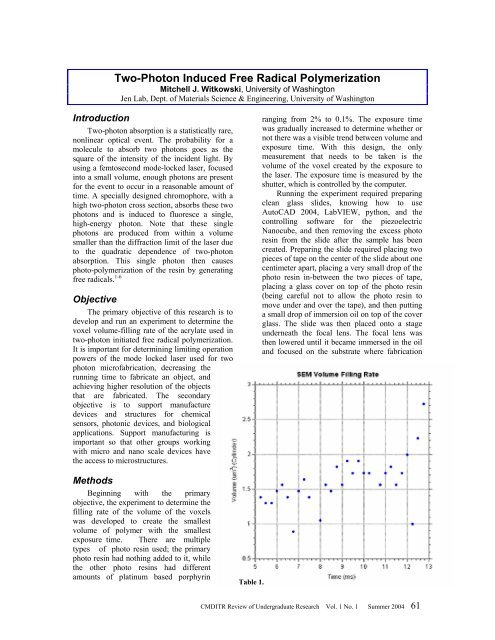CMDITR Review of Undergraduate Research - Pluto - University of ...
CMDITR Review of Undergraduate Research - Pluto - University of ...
CMDITR Review of Undergraduate Research - Pluto - University of ...
Create successful ePaper yourself
Turn your PDF publications into a flip-book with our unique Google optimized e-Paper software.
Two-Photon Induced Free Radical Polymerization<br />
Mitchell J. Witkowski, <strong>University</strong> <strong>of</strong> Washington<br />
Jen Lab, Dept. <strong>of</strong> Materials Science & Engineering, <strong>University</strong> <strong>of</strong> Washington<br />
Introduction<br />
Two-photon absorption is a statistically rare,<br />
nonlinear optical event. The probability for a<br />
molecule to absorb two photons goes as the<br />
square <strong>of</strong> the intensity <strong>of</strong> the incident light. By<br />
using a femtosecond mode-locked laser, focused<br />
into a small volume, enough photons are present<br />
for the event to occur in a reasonable amount <strong>of</strong><br />
time. A specially designed chromophore, with a<br />
high two-photon cross section, absorbs these two<br />
photons and is induced to fluoresce a single,<br />
high-energy photon. Note that these single<br />
photons are produced from within a volume<br />
smaller than the diffraction limit <strong>of</strong> the laser due<br />
to the quadratic dependence <strong>of</strong> two-photon<br />
absorption. This single photon then causes<br />
photo-polymerization <strong>of</strong> the resin by generating<br />
free radicals. 1-6<br />
Objective<br />
The primary objective <strong>of</strong> this research is to<br />
develop and run an experiment to determine the<br />
voxel volume-filling rate <strong>of</strong> the acrylate used in<br />
two-photon initiated free radical polymerization.<br />
It is important for determining limiting operation<br />
powers <strong>of</strong> the mode locked laser used for two<br />
photon micr<strong>of</strong>abrication, decreasing the<br />
running time to fabricate an object, and<br />
achieving higher resolution <strong>of</strong> the objects<br />
that are fabricated. The secondary<br />
objective is to support manufacture<br />
devices and structures for chemical<br />
sensors, photonic devices, and biological<br />
applications. Support manufacturing is<br />
important so that other groups working<br />
with micro and nano scale devices have<br />
the access to microstructures.<br />
Methods<br />
Beginning with the primary<br />
objective, the experiment to determine the<br />
filling rate <strong>of</strong> the volume <strong>of</strong> the voxels<br />
was developed to create the smallest<br />
volume <strong>of</strong> polymer with the smallest<br />
exposure time. There are multiple<br />
types <strong>of</strong> photo resin used; the primary<br />
photo resin had nothing added to it, while<br />
the other photo resins had different<br />
amounts <strong>of</strong> platinum based porphyrin<br />
Table 1.<br />
ranging from 2% to 0.1%. The exposure time<br />
was gradually increased to determine whether or<br />
not there was a visible trend between volume and<br />
exposure time. With this design, the only<br />
measurement that needs to be taken is the<br />
volume <strong>of</strong> the voxel created by the exposure to<br />
the laser. The exposure time is measured by the<br />
shutter, which is controlled by the computer.<br />
Running the experiment required preparing<br />
clean glass slides, knowing how to use<br />
AutoCAD 2004, LabVIEW, python, and the<br />
controlling s<strong>of</strong>tware for the piezoelectric<br />
Nanocube, and then removing the excess photo<br />
resin from the slide after the sample has been<br />
created. Preparing the slide required placing two<br />
pieces <strong>of</strong> tape on the center <strong>of</strong> the slide about one<br />
centimeter apart, placing a very small drop <strong>of</strong> the<br />
photo resin in-between the two pieces <strong>of</strong> tape,<br />
placing a glass cover on top <strong>of</strong> the photo resin<br />
(being careful not to allow the photo resin to<br />
move under and over the tape), and then putting<br />
a small drop <strong>of</strong> immersion oil on top <strong>of</strong> the cover<br />
glass. The slide was then placed onto a stage<br />
underneath the focal lens. The focal lens was<br />
then lowered until it became immersed in the oil<br />
and focused on the substrate where fabrication<br />
<strong>CMDITR</strong> <strong>Review</strong> <strong>of</strong> <strong>Undergraduate</strong> <strong>Research</strong> Vol. 1 No. 1 Summer 2004 61




